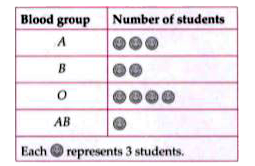For the MN-blood group system. The frequencies of M and N alleles are 0.7 and 0.3, respectively. The expected frequency of MN-blood group bearing organisms is likely to be
0.42
0.49
0.09
0.58
The correct Answer is:A
To find the expected frequency of MN blood group bearing organisms in the MN blood group system, we can use the Hardy-Weinberg principle. Here’s a step-by-step solution:
Step 1: Understand the Allele Frequencies
We are given the frequencies of the M and N alleles:
- Frequency of M (p) = 0.7
- Frequency of N (q) = 0.3
Step 2: Identify the Genotype Frequencies
According to the Hardy-Weinberg principle, the expected frequencies of the genotypes in a population can be calculated using the formula:
p2+2pq+q2=1
Where:
- p2 = frequency of homozygous MM
- 2pq = frequency of heterozygous MN
- q2 = frequency of homozygous NN
Step 3: Calculate Each Genotype Frequency
1. Calculate p2 (frequency of MM):
p2=(0.7)2=0.49
2. Calculate q2 (frequency of NN):
q2=(0.3)2=0.09
3. Calculate 2pq (frequency of MN):
2pq=2×(0.7)×(0.3)=2×0.21=0.42
Step 4: Summarize the Frequencies
Now we have:
- Frequency of MM = p2=0.49
- Frequency of NN = q2=0.09
- Frequency of MN = 2pq=0.42
Step 5: Conclusion
The expected frequency of MN blood group bearing organisms is 0.42 or 42%.
Final Answer
Thus, the expected frequency of MN blood group bearing organisms is 42%.
---
We are given the frequencies of the M and N alleles:
- Frequency of M (p) = 0.7
- Frequency of N (q) = 0.3
According to the Hardy-Weinberg principle, the expected frequencies of the genotypes in a population can be calculated using the formula:
p2+2pq+q2=1
Where:
- p2 = frequency of homozygous MM
- 2pq = frequency of heterozygous MN
- q2 = frequency of homozygous NN
1. Calculate p2 (frequency of MM):
p2=(0.7)2=0.49
q2=(0.3)2=0.09
2pq=2×(0.7)×(0.3)=2×0.21=0.42
Now we have:
- Frequency of MM = p2=0.49
- Frequency of NN = q2=0.09
- Frequency of MN = 2pq=0.42
The expected frequency of MN blood group bearing organisms is 0.42 or 42%.
Thus, the expected frequency of MN blood group bearing organisms is 42%.
Topper's Solved these Questions
Similar Questions
The gene that controls the ABO blood group system in human beings has three alleles −IA,IB and i. A child has blood group O. His father has blood group A and mother has blood group B. Genotypes of other off springs can be:
i.IBIB
ii.IAi
iii.IBi
iv.IAIB
v.iiView SolutionObserve the following pictograph and answer the following questions.

The ratio of the frequencies of blood group A to blood group B isView Solution
Knowledge Check
- Question 1 - Select One
For the MN-blood group system, the frequencies of M and N alleles are 0.7 and 0.3 respectively. The expected frequency of MN-blood group bearing oranisms is likely to be
A42%B49%C9%D58% - Question 2 - Select One
For the MN-blood group system, the frequencies of M and N alleles are 0.7 m and 0.3, respectively . The expected frequency of MN-blood group bearing organisms in likely to be
A42%B49%C9%D58% - Question 3 - Select One
For the M-N blood group system, the frequencies of M and N alleles are 0.7 and 0.3, respectively. The expanded frequency of M-N group bearing organisms is likely to be
A0.42B0.49C0.09D0.5
In humans, MN blood group is an example of
View SolutionThe gene that controls the ABO blood group system in human beings has three alleles-IA,IB and i. A child has blood group O. His father has blood group A and mother has blood group (B) Genotypes of other off springs can be:
(I) IBIB
(II) IAi
(III) IBi
(IV) IAIB
(V) iiView SolutionA population is in Hardy-Weinberg equilibrium for a gene with only 2 alleles . If the gene frequency of an allele A is 0.7 , the genotypic frequency of homozygous recessive individuals will be
View SolutionIn a random mating population frequency of dominent allele is 0.7. What will be the frequency of homozygous dominant phenotype.
View SolutionIn a population of 278,if observed number of 'MM','MN' and 'NN' blood group is 78,138 and 62 respectively ,what would be the frequency of 'M'?
View Solution

